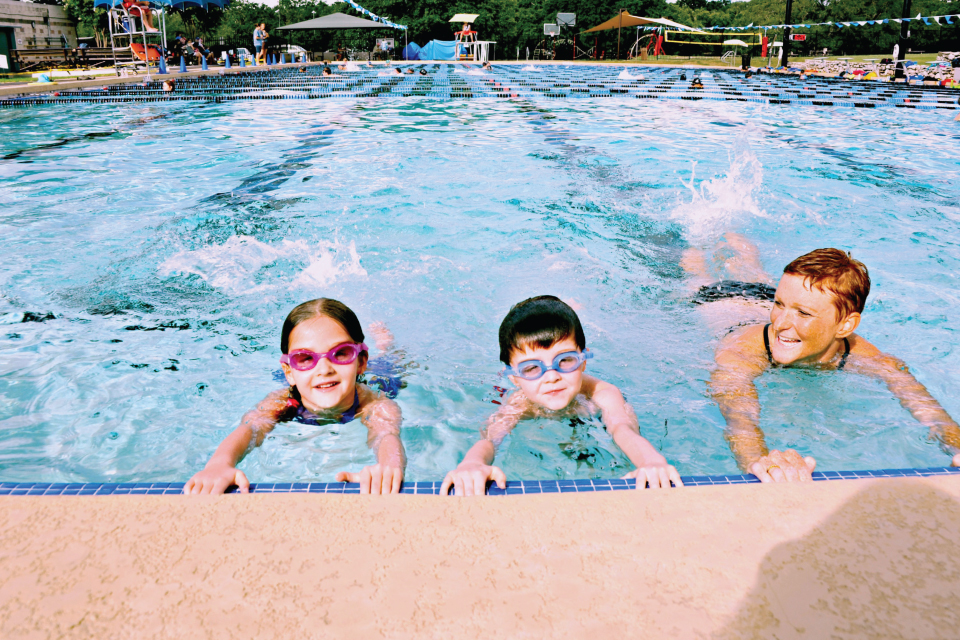Encouraging Your Kids to be Stronger Swimmers

We are well into summer and your kids are probably spending every spare minute in the water. Maybe you ponder taking them to swim lessons or joining a swim team to turn their paddling into “swimming” but your kids already have so many activities squeezed into their week that you just can’t find the time. Don’t despair! Here are five ways to encourage your kids to be stronger swimmers while you play at the pool.
Get Horizontal
Efficient swimmers move horizontally through the water. Most kids learn to swim vertically first, more like a running man in the pool than a swimmer. Even the majority of adults swim with their heads too high, leaving their body at an angle that makes it hard to drag through the water. Kids ages 4 or older are developmentally ready to learn to swim parallel to the surface.
Face In!
You can’t achieve a horizontal position without your face submerged. Kids need to feel comfortable in this position, but many find it terrifying. If your child is a submariner or a mermaid (one who loves to swim beneath the surface), please skip ahead. However, if your children dislike getting their face wet (you know, the kids who can be in the water for an hour and the top of their hair is still dry), the first step is building their confidence in submerging their face. Be supportive and gradual with this process; stay in shallow water, where they feel safe. Get some goggles so they can see underwater. Start out just wetting their face. Then, make a game of looking under the water, holding toys under for them to look at or fetch, or have them count how many fingers you’re showing underwater. Have them hold on to the side of the pool and bob up and down, gradually getting wetter. It can help to have your children hold their breath out of the water; then, you can suggest they put their mouth under the surface and hold their breath. Once they can confidently hold their breath with their face in the water, you can move on to blowing bubbles.
Breathe and Bubble
To swim well, kids need to breathe out when their face is in the water. When you turn your head in freestyle, you need to use that time to breathe in. Even kids who like to play under the water may not realize they should breathe out under there when it comes to real swimming. Demonstrate this with your kids as they bob up and down, breathing out when they are under and taking one breath in when they come up.
Swimming Feet
Lots of kids have “running legs and feet” in the water. Unfortunately, this doesn’t get you far! Developing “swimming feet” is a key step to make the transition to real swimming. “Swimming feet” means holding the foot in a relaxed toe point and kicking with the legs straight out behind so that the feet are break the surface, making bubbles or splashes. Kids love holding on to the side of the pool and seeing how much splash they can make; guide them so that they keep their legs almost straight (there should not be a significant knee bend as they kick upwards) and do small, fast kicks, where their feet don’t come too far apart. Your kids can also practice with a kick board or a noodle, kicking to the other side of the pool while they keep their arms straight out and holding the board or noodle to the front. Have races with them to make it fun!
“Big Arms” and Breathing to the Side
The two trickiest parts to swimming properly are changing the underwater paddling stroke to a full stroke (where the arms come out of the water) and getting kids to breathe by turning their heads to the side. It helps to demonstrate this on land and have the kids practice it standing beside the pool. Their arms should look like they are wind milling, pulling the water from in front of their heads all the way to beside their legs, then letting their arms come out and around. The breath is taken to the side when the hand on the breathing side is down by their leg. Their heads, as they turn, should be resting on their outstretched arm like a pillow. It helps for them to pick one side on which to breathe and one side to bubble. Let your kids practice one full arm pull at a time by holding on to the bottom of a kickboard as they do it, one arm pull followed be the other, or you can cut a foot-long piece of noodle and have them hold on to that.
Whatever you do, remember to keep it fun and encouraging!






